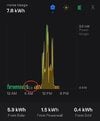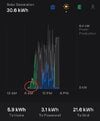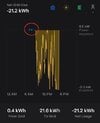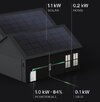My Settings
Brand new solar and Powerwall install, self-powered mode, 30% reserve, grid charging off
Symptoms
In the morning, when solar production starts and the battery is above reserve, I see some odd behaviour in the screenshots attached.
The documented behaviour for my settings is for the solar to prioritise the house, and charge the battery with excess solar. What I'm seeing is bursts of 0.1 kW drawn from the grid to supplement power to the house, even though the solar is producing enough on its own. It sort of alternates between drawing from the grid and not drawing from the grid. The graphs for this time period look a bit funny, almost like a gap where I should see more home usage.
This is the only time I see errant grid usage: that window of time during charging and solar production. When solar production has stopped and the battery is discharged to the home, everything continues to work as it should.
I've reported this to Tesla and it has been escalated, but I was wondering if anyone else sees something similar? I did find the thread below, but this seems to be a fairly edge case with an odd system design. My system is doesn't share those issues as far as I know.
Solar pulling from grid vs Powerwall [in small amounts]
I realise this total grid use is fairly small, but I would like to get to the bottom of whether there's a misconfiguration in my system.
Brand new solar and Powerwall install, self-powered mode, 30% reserve, grid charging off
Symptoms
In the morning, when solar production starts and the battery is above reserve, I see some odd behaviour in the screenshots attached.
The documented behaviour for my settings is for the solar to prioritise the house, and charge the battery with excess solar. What I'm seeing is bursts of 0.1 kW drawn from the grid to supplement power to the house, even though the solar is producing enough on its own. It sort of alternates between drawing from the grid and not drawing from the grid. The graphs for this time period look a bit funny, almost like a gap where I should see more home usage.
This is the only time I see errant grid usage: that window of time during charging and solar production. When solar production has stopped and the battery is discharged to the home, everything continues to work as it should.
I've reported this to Tesla and it has been escalated, but I was wondering if anyone else sees something similar? I did find the thread below, but this seems to be a fairly edge case with an odd system design. My system is doesn't share those issues as far as I know.
Solar pulling from grid vs Powerwall [in small amounts]
I realise this total grid use is fairly small, but I would like to get to the bottom of whether there's a misconfiguration in my system.







